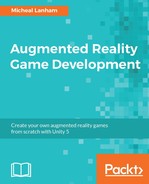Even though we missed or barely touched some of these areas of development for our demo game, they will indeed be critical to completing a stunning commercial or just cool game in the genre. The following is a prioritized list of development skills, with a sublist of resources, which you should direct your attention to after completing this book:
- Shaders (visual effects and lighting): This is a broad topic and you would likely never have to write a shader, but you will certainly have to learn how to use them effectively. Shaders are to game development like air is to breathing; essential and everywhere. Learning to develop shaders is an advanced skill, but even a little knowledge can go a long way. Even if you plan not to write your own shaders, the following resources are worth taking a look at:
- WikiBooks: (https://en.wikibooks.org/wiki/Cg_Programming/Unity), has a good introduction to shader programming and a good set of resources. The site may be overwhelming to beginners or those that like to follow a learning path, in a good book for example.
- Mastering Unity Shader and Effects (2016) by Jamie Dean, Packt Publishing is an excellent book and a good introduction for those new to shader development.
- Unity 5.x Shaders and Effects Cookbook (2016), Alan Zucconi, Kenny Lammers, Packt Publishing is an excellent, although more advanced book. Check this one out last.
- Particle effects: Again, this is a skill you can likely get by without, but there will come a time when you want that extra special-particle effect, which will require knowledge of building or modifying a custom-particle effect. Even having knowledge of how the various settings on the Unity particle system may be helpful when just tweaking a particle system for your needs. Here is a list of resources that you may find helpful to improve your knowledge of the Unity particle system:
- Unity Learning (https://unity3d.com/learn/tutorials/topics/graphics/particle-system), is a great introduction to use the particle effects system
- Mastering Unity Shader and Effects (2016) by Jamie Dean, Packt Publishing, has a good section on developing shaders for particle effects
- Multiplayer (networking): Of course, if you want to convert the demo game to an Massively Multiplayer Online (MMO) game, then this skill will be essential. Unfortunately though, the required specific skills and knowledge in this area will often depend on the networking infrastructure your game depends on. We will get into why this is so and talk about various networking solutions and resources later in this chapter.
- Animation (Mecanim): Many developers will automatically assume animation and Mecanim is just for animating characters or humanoids. While that certainly is true, you can accomplish several things with Mecanim animations, including of course character animation. Here are some great resources on animation in Unity:
- Unity Learning, (https://unity3d.com/learn/tutorials/topics/animation/animate-anything-mecanim) is a good quick tutorial on using Mecanim.
- Unity Animation Essentials (2015) by Alan Thorn, Packt Publishing, is a good short introduction to animation.
- Unity Character Animation with Mecanim (2015) by Jamie Dean, Packt Publishing, is another excellent book by Jamie. There is a lot of good material in this book.
- Audio: This is one of those often overlooked skills that are so essential to good games. Of course, the other issue is that there is very little information out there about the best practices of adding sound and music to a Unity game. Sounds like this would be another good topic for a book, but until then, here are a couple of resources:
- Unity Learning (https://unity3d.com/learn/tutorials/topics/audio/audio-listeners-sources?playlist=17096) is a good place to start
- Unity Learning (https://unity3d.com/learn/tutorials/topics/audio/sound-effects-unity-5?playlist=17096) is a good discussion on sound effects
- Texturing: This is the art of overlaying 2D images onto a 3D model. It is a skill that falls outside development, but if you are a small indie developer working on your own game, some knowledge in this area will be beneficial. This skill aligns itself well with or as a part of 3D modeling. It is also an extension of shaders and shader programming. Here is a good starting point on physically-based substances (textures/materials) with Unity:
- Unity Learning (https://unity3d.com/learn/tutorials/modules/intermediate/graphics/substance/introduction) is a rather advanced tutorial series using Substance designer from Allegorithmic, but it is certainly worth taking a look at by anyone interested in getting insights into the next level of game development
- 3D modeling (character development): This is another skill game developers could do without and still do well. There is certainly enough 3D content out there. However, learning just the workflow of modeling a 3D object or character can be another great addition to your skill set. Not to mention, if you are indie developer, at some point you will be opening a 3D modeling program to build a custom model. Of course, some of the skills you learn in this area will be specific to the software you are using. Here are a couple of software-specific packages with tutorials that will help you get started:
- iClone Character Creator (Reallusion), https://www.reallusion.com/iclone/game/ , is an excellent software package with a good selection of tutorial videos that will allow you to easily create custom characters. If you forgot, the characters used in this game are iClone characters provided free from Reallusion.
- Blender, https://www.blender.org/,is the standard free tool for modeling 3D content. It does require an investment in time to get familiar with this tool.
Of course, if you don't have time to spend improving skills, you can always look for an asset in the Unity Asset Store for complete functionality. We will discuss several guidelines on selecting and using assets in the next section.
..................Content has been hidden....................
You can't read the all page of ebook, please click here login for view all page.
